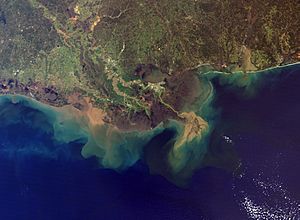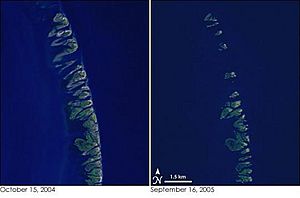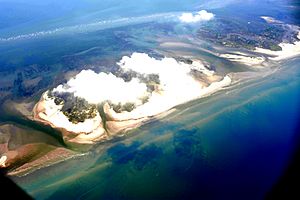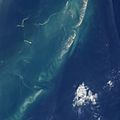Chandeleur Sound facts for kids
The Chandeleur Sound is a large area of water located off the coast of Louisiana. It sits between the mainland of Louisiana and a chain of islands called the Chandeleur Islands. This sound is formed where the waters of the Gulf of Mexico mix with the Mississippi River. The islands act like a natural barrier, protecting the sound from the open Gulf.
Contents
Chandeleur Sound: Weather and Location
The Chandeleur Sound has a warm, humid climate, much like the rest of Louisiana. Water temperatures usually stay between 70˚F and 84˚F throughout the year. The air is often humid, ranging from 73% to 84%. Because of this humidity, clouds often form, which can reduce the amount of sunshine the area gets each day. The Sound is part of the Breton National Wildlife Refuge. It is also close to the Bayou Sauvage National Wildlife Refuge.
Hurricane Katrina's Impact
In 2005, Hurricane Katrina hit the area as a powerful storm. It destroyed a large part of the Chandeleur Islands. This left some areas of the Sound more open to the strong waves and winds of the Gulf of Mexico.
How People Use the Sound
The Chandeleur Sound has been important for a long time, especially for fishing. It is located near the New Orleans metropolitan area. People have used the Sound for various activities since the city of New Orleans was settled in 1718.
Boats and Travel
Fishermen from both Mississippi and Louisiana can easily reach the Sound. The Chandeleur Islands help protect the Sound from rough ocean conditions. This means that many different sizes of boats can safely travel here. Most boats that enter the Sound are used for fishing.
Fishing Fun
Fish are a very important product from this region. Popular types of fish caught here include Redfish and Speckled trout. The many fish in the Sound helped the region grow and thrive. People settled here as early as 1718 when the French arrived in New Orleans. Other fish found in the Sound include Flounder, Bluefish, Spanish mackerel, Cobia, Tarpon, and Jack crevalle. The best time for fishing is during the Summer. The Sound has supported the city of New Orleans for over 300 years. However, fishing was stopped for a while after a big oil spill in 2010.
Environmental Challenges
The Chandeleur Sound has faced some environmental difficulties.
The 2010 Oil Spill
In 2010, a major oil spill happened in the Gulf of Mexico. It was from an oil rig called the Deepwater Horizon. Millions of barrels of oil spilled into the water. This oil reached the coasts of Louisiana, Mississippi, Alabama, Florida, and some parts of Texas. Louisiana's coastal marshes were hit very hard by the spill. It happened only about forty miles from the state's coast. More than 450 miles of the Chandeleur Sound's coastline and marshes were covered in oil and damaged. This human-caused event greatly sped up the loss of these important marsh areas.
Mysterious Dead Zones
In 2008, scientists found a "dead zone" in the Sound. This area grew much larger after the oil spill. A dead zone is a place in the water with very low amounts of oxygen. This low oxygen is called hypoxia. It makes it hard for fish and other sea creatures to live there. Scientists believe these dead zones start when too many waste nutrients, like phosphorus and nitrogen, flow into the water from the Mississippi River. These nutrients can block sunlight. The oil spill made the problem worse. Dead zones tend to grow the most during the summer. This is when the flow of these nutrients is usually highest.
Images for kids





